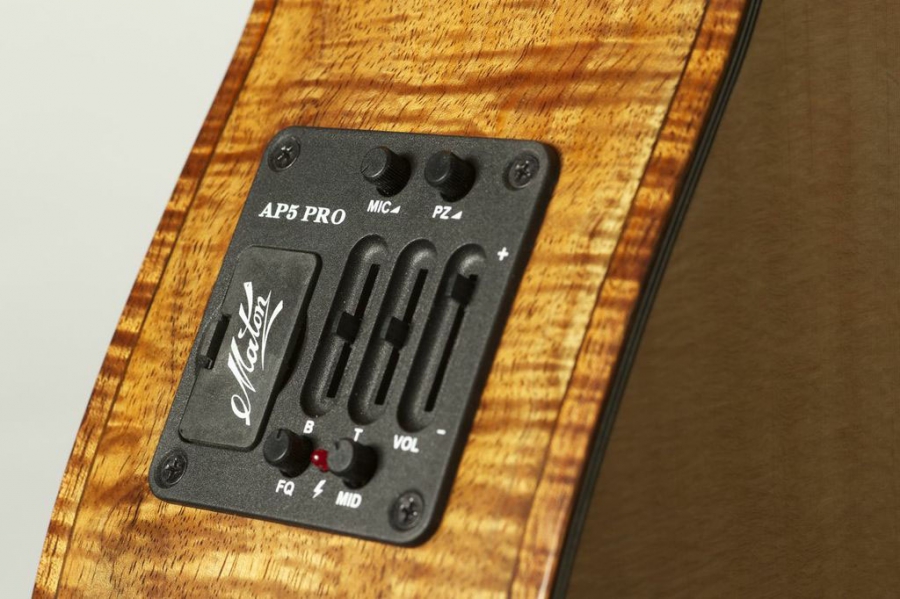
As the AP5 has been in the field for a number of years, it is logical for Maton to plan a replacement for it before someone else does! - so begins our journey to the AP5-Pro.....Using the Maton AP5 as a starting position, we developed AP5 Revision 2 by 19th March 2009.
The first brief was to remove the 800Hz 'honk' with the current system and a notch filter was developed to achieve this end. Thus started the listening process. In association with Patrick Evans and Anthony Knowles as the 'Ears' the AP5 Rev 2 went through repeated major changes with associated fine tuning.
We developed 2 extra controls, one a high frequency 'presence' and the other a super-low bass (which became known as 'icky-thump'!) - both were fine tuned to the most acceptable/usable audio bands.
This resulted in the production of 16 simulations and development of 20 separate variations of the Printed Circuit Board during this time.
Each of these documented variations have had many fine tunings - typically 15 or more adjustments, followed by listening sessions after each adjustment. With a little math we can work out about 300 listening sessions regarding adjustments!
During this development time the physical layout was changed and the battery box moved to the end of the PCB to allow the visual layout to be equal to both right-handed and left-handed players. Also addressed was the problems associated with the 'falling out' of the 3.5mm jacks – these were replaced with latching quick connectors to improve reliability in transport.
The first generation of production PCB's called the AP6 went to the production house on 26 Nov
2009. This PCB had input for Piezo pickup, Microphone and 1 extra to allow for future sensors. Controls consisted of 5 slider, Bass, Treble Volume and the new Presence and Sub Bass. The 5 rotary controls consisted of the modified midrange sweep (750-2000Hz) and boost/cut plus individual level controls for the Piezo, Microphone and ToBeAdvised input.
Complete populated boards were delivered in Feb 2010 and the fine adjustment process continued. Four more Simulations and 9 more PCB's were developed during the next 4 months, again with many scores of listening sessions followed by more adjustments. During these tests the Presence control was discarded.
During this development time we often thought that we had 'arrived' at Nirvana, only to be disappointed by 'the morning after' listening tests. The feedback from a listening session with Tommy Emmanuel was very positive “best recordable sound I have ever heard”.
As so many changes were making the existing PCB more difficult to work with, a new layout was suggested with the 3 input rotary controls along the left hand side of the PCB, and to allow easier changes 6 miniature adjustable components were applied. These allowed individual adjustment of the 3 separate input stages, Bass and Midrange changes, and overall output level.
This PCB – called AP6 Revision A-6 Trimpot Version went to production on 14th April 2010.
By 11th August, this PCB had been fine tuned to AP6 Rev A-6 Beta, and the listening sessions continued... During this time we produced a preamp that would have been perfect as floor stock in the shops – it sounded so good, that punters would have bought it on the spot! - it sounded very average on a PA system.
3 more simulations and 5 more PCB's were finalized reaching the AP6 Revision E1. The layout had been changed back to the battery box on the side of the preamp, as the area was now free again after the removal of the Presence and Sub Bass controls. This PCB was sent for Blank PCB production, and at that time samples were sent out to artists.
Artists feedback was mixed, with overall a negative slant – more changes were needed....
During this time a 'quiet' microphone was sourced and listening tests began including a microphone for the first time. This mic was so good that 2 were used! - one near the sound hole and one near the output jack.
On 19th April 20011 this PCB was taken into the Palace Theatre in Melbourne and used on a Big Rig PA system. At very high listening levels, the performers and our staff agreed that the old AP5 was still better suited!
By the 21st April 2011 we though we had the 'perfect' example AP6 Revision M2a of which 4 samples were produced on Good Friday! - by Easter Tuesday these samples were out of date!
AP6 Revision M2B was sent for blank PCB production on 25th May 2011 partly so that mechanical details could be finalized for case development.
By late May, it became obvious that these changes could go on forever, and it was decided to produce an updated AP5, with just an expanded Mid Sweep (600Hz-2000Hz) and a single Microphone input with Bass cut control. This was completed within 2 weeks.
This ended the journey of 28 simulations, 46 completed PCB's and many hundreds of listening tests.
The AP5-Pro was sent out for full production on 15th June 2011
Future development may involve a 'horses for courses' approach, with a preamp allowing for beginner, intermediate and artist variations approach.
By late May it was decided to concentrate on producing an updated AP5 with respect to the following criteria:
1/ better overall sound
2/ more linear feel to the controls,
3/ expanded Mid Sweep range (600Hz-2400Hz)
4/ a much better and more usable Microphone system.
This PCB design and layout was completed and the AP5-Pro PCB was sent out for full production.